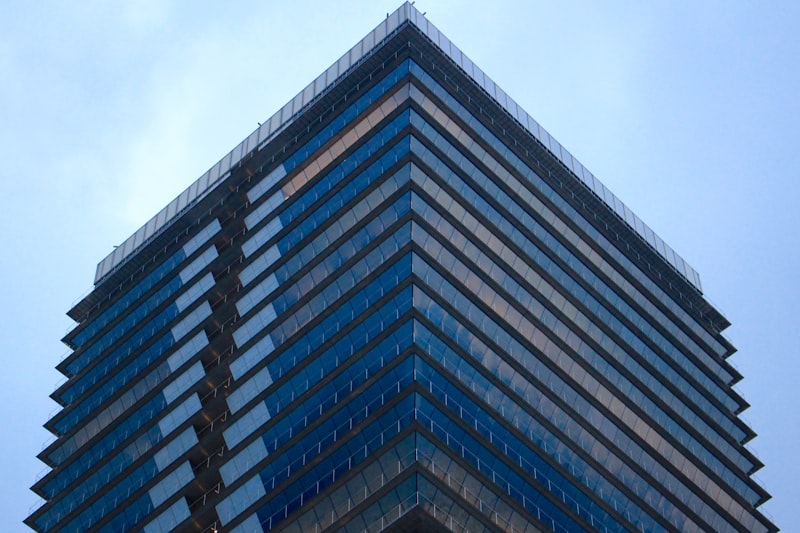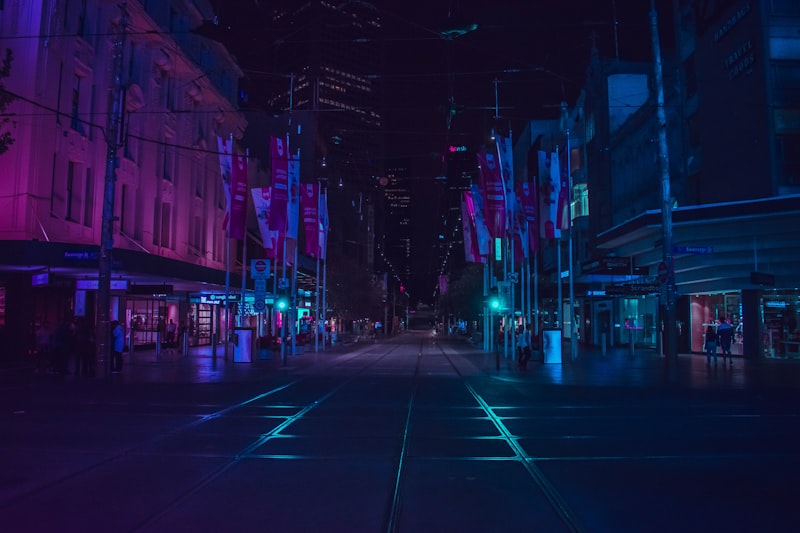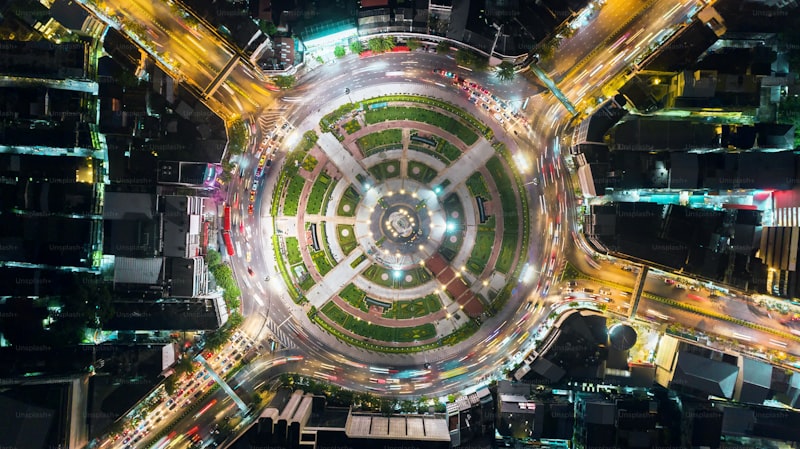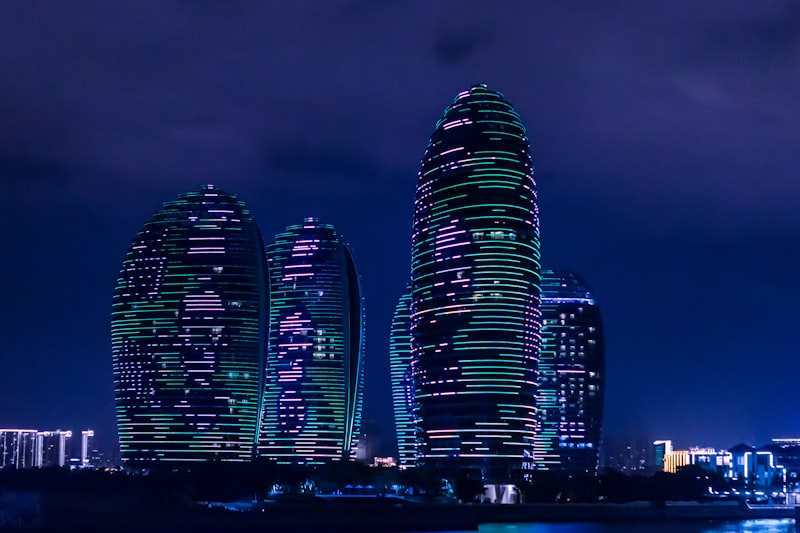Imagine a world where towering skyscrapers kiss the clouds, neon lights dance on the streets, and flying cars zip through the sky. Sci-fi films have long captured our imagination with their portrayal of futuristic cities that defy the limits of today’s urban landscapes. From the dystopian sprawls of “Blade Runner” to the sleek metropolis of “The Fifth Element,” these films transport us to worlds where technology and architecture blend seamlessly into visions of tomorrow.
In “Blade Runner,” Ridley Scott paints a gritty picture of Los Angeles in 2019, transformed into a rain-soaked labyrinth of towering megastructures and bustling streets teeming with life. The film’s iconic imagery of neon-lit skyscrapers and crowded marketplaces underlines its vision of a future where humanity coexists with advanced artificial beings.

On the other hand, “The Fifth Element” takes us on a journey to the 23rd century, where New York City is transformed into a bustling, high-tech urban center. Its skyline dominated by pyramid-shaped skyscrapers and flying vehicles showcases a world where innovation has reshaped every aspect of daily life.
These films not only entertain but also provoke thought about the direction our own cities might take in the future. They challenge us to consider how technology, architecture, and social dynamics could evolve and intersect in the decades to come. What would it be like to live in a city where every building is a marvel of engineering, and every street corner holds the promise of discovery?
As viewers, we are left with a sense of awe and wonder at these cinematic creations. They remind us that the future is not just a continuation of the present but a canvas upon which we can paint our dreams and aspirations. So, the next time you watch a sci-fi film set in a futuristic city, let yourself be transported to a world where the possibilities are as endless as the stars themselves.
10 Sci-Fi Films That Redefine Urban Landscapes with Futuristic Cities
Science fiction films have long been captivating audiences with their imaginative portrayals of future societies and cities. From towering skyscrapers to sprawling megacities, these movies transport us to worlds where urban landscapes are redefined beyond imagination. Let’s delve into 10 sci-fi films that push the boundaries of creativity when it comes to futuristic cities.
-
Blade Runner (1982) – Ridley Scott’s masterpiece introduced us to the dystopian city of Los Angeles in 2019, where massive skyscrapers loom over dark, rain-soaked streets. The film’s visual style, influenced by film noir, remains iconic to this day.
-
Metropolis (1927) – Fritz Lang’s silent classic envisioned a divided city where the elite live in luxury high above the oppressed working class. Its grand, Art Deco-inspired architecture set a benchmark for futuristic cityscapes in cinema.
-
The Fifth Element (1997) – Luc Besson’s visually stunning film presents a vibrant, multicultural future New York City complete with flying cars, towering buildings, and bustling markets, blending various architectural styles with a sense of grandeur.
-
Minority Report (2002) – Steven Spielberg’s adaptation of Philip K. Dick’s story showcases a Washington, D.C. in 2054 where advanced technology predicts crimes before they happen, featuring sleek, high-tech skyscrapers and innovative transportation systems.
-
Akira (1988) – Katsuhiro Otomo’s anime masterpiece depicts a post-apocalyptic Tokyo rebuilt as a sprawling metropolis dominated by towering skyscrapers and neon lights, reflecting both awe and the dark side of technological advancement.
-
Ghost in the Shell (1995) – This anime film envisions a cyberpunk future where humans and machines coexist in a sprawling cityscape of interconnected skyscrapers and digital networks, exploring themes of identity and artificial intelligence.
-
The Matrix (1999) – The Wachowskis’ groundbreaking film presents a world where reality is simulated, and humans live in an artificial cityscape controlled by machines. The city of Zion provides a stark contrast with its underground, industrial aesthetic.
-
Elysium (2013) – Neill Blomkamp’s film depicts a future where the wealthy live on a luxurious space station while the rest struggle in overpopulated and impoverished Earth cities, highlighting the disparity between social classes through contrasting urban landscapes.
-
Inception (2010) – Christopher Nolan’s mind-bending thriller features dreamscapes that include cities folding onto themselves and gravity-defying architecture, blurring the lines between reality and imagination in urban settings.
-
Alita: Battle Angel (2019) – Robert Rodriguez’s adaptation of Yukito Kishiro’s manga brings to life the futuristic city of Iron City, a cyberpunk metropolis filled with towering skyscrapers and bustling markets under a sky full of floating city fragments.
These films not only entertain but also challenge our perceptions of what cities could become in the future. Through their imaginative urban landscapes and architectural marvels, they continue to inspire generations of filmmakers and audiences alike.
Exploring the Spectacular Futuristic Cities in Sci-Fi Cinema
Imagine strolling through the neon-lit streets of “Blade Runner’s” Los Angeles, where towering skyscrapers pierce the sky, and flying cars zip through the air. The cityscape is a blend of retro noir and cyberpunk, depicting a future both awe-inspiring and dystopian. Each corner holds a story, each holographic billboard a glimpse into a future where humanity’s relationship with technology shapes every aspect of life.
In contrast, “The Fifth Element” presents New York City in the 23rd century, where the skyline is a mosaic of floating highways and colossal pyramids. Here, ancient Egyptian motifs blend seamlessly with high-tech marvels, creating a visual tapestry that reflects a society thriving on innovation and cultural fusion. It’s a city where every architectural detail tells a story of humanity’s boundless creativity and adaptability.
Traveling to the world of “Metropolis,” we encounter a city that symbolizes the divide between social classes and the consequences of unchecked industrialization. Its towering skyscrapers and sprawling underground factories depict a society on the brink of collapse, where the elite dwell in luxury above ground while workers toil tirelessly below. The city’s labyrinthine structure mirrors the complexities of power and inequality, echoing timeless themes that resonate with audiences to this day.
These futuristic cities not only serve as visual feasts but also as narrative devices that explore profound themes of human nature, society, and the consequences of technological advancement. They challenge us to envision the possibilities and pitfalls of our future, urging us to reflect on the paths we choose to tread as a civilization.
Step into these cinematic marvels, where each skyline, each bustling street corner, invites you to ponder the limitless potential of human imagination and the ever-evolving relationship between humanity and its creations. As we continue to explore these futuristic cities on screen, we are reminded of our capacity for innovation, our resilience in the face of adversity, and our eternal quest for progress in a world yet to come.
From Metropolis to Blade Runner: Iconic Futuristic Cities in Film History
Metropolis, Fritz Lang’s 1927 masterpiece, introduced the world to a dystopian city of stark contrasts. Its towering architecture and sprawling underworld depicted a society divided between the elite above ground and oppressed workers below. This visual metaphor of class struggle resonated deeply and set a standard for futuristic urban landscapes in cinema.
Moving forward to Ridley Scott’s Blade Runner in 1982, we encounter a starkly different yet equally influential cityscape. The film’s vision of Los Angeles in 2019, though now our past, remains a hauntingly plausible future with its perpetual rain, towering skyscrapers adorned with colossal billboards, and streets bustling with a diverse array of cultures. The city became a character itself, a labyrinthine backdrop against which the film’s exploration of humanity and artificial intelligence unfolded.
What makes these cities iconic goes beyond their visual aesthetics. They serve as reflections of societal fears, aspirations, and critiques. Metropolis reflected anxieties about industrialization and social inequality, while Blade Runner delved into themes of technology, identity, and corporate dominance. These cities are not just backdrops but integral to the storytelling, enhancing the narrative impact and leaving lasting impressions on audiences worldwide.
As technology advances and our world changes, filmmakers continue to imagine new futures, each city building upon the legacy of those that came before. Whether it’s the sleek utopias of Star Trek or the gritty dystopias of Mad Max, futuristic cities in film continue to inspire, provoke thought, and fuel our collective imagination about what lies ahead.
Top 10 Must-Watch Sci-Fi Movies Featuring Jaw-Dropping Futuristic Cities
Are you ready to embark on a cinematic journey through awe-inspiring futuristic cities? Sci-fi movies have long captivated audiences with their imaginative portrayal of urban landscapes that defy the boundaries of time and space. From towering skyscrapers to neon-lit streets, these films transport viewers to worlds where technology and architecture converge in spectacular ways. Here are the top 10 must-watch sci-fi movies featuring jaw-dropping futuristic cities that will leave you spellbound.
-
Blade Runner (1982): Ridley Scott’s masterpiece introduces us to a dystopian Los Angeles in 2019, complete with massive skyscrapers and perpetually raining streets, showcasing a blend of noir and futuristic aesthetics.
-
The Fifth Element (1997): Luc Besson’s visually stunning film presents a bustling New York City in the 23rd century, where flying cars zip through towering megastructures amidst a backdrop of vibrant colors.


Metropolis (1927): A pioneering work in sci-fi cinema, Fritz Lang’s Metropolis depicts a sprawling city divided between the opulent above-ground elites and the oppressed workers toiling below, all set in a visually striking art deco environment.
-
Ghost in the Shell (1995): Masamune Shirow’s cyberpunk anime adaptation explores a future Japan where cybernetic enhancements are commonplace, blending traditional architecture with ultra-modern skyscrapers.
-
Inception (2010): Christopher Nolan’s mind-bending thriller takes us through dreamscapes that include a futuristic cityscape folding onto itself, bending the rules of physics and architecture in breathtaking ways.
-
The Matrix (1999): The Wachowskis’ iconic film introduces us to the simulated reality of the Matrix, contrasting a gritty urban world with the sleek, minimalist design of the Nebuchadnezzar hovercraft.
-
Minority Report (2002): Steven Spielberg’s adaptation of Philip K. Dick’s story envisions a future Washington D.C. where advanced technology predicts crimes, featuring sprawling highways and towering glass buildings.
-
Akira (1988): Katsuhiro Otomo’s anime masterpiece is set in a cyberpunk Tokyo ravaged by political unrest and psychic phenomena, showcasing a cityscape filled with neon lights, motorcycle chases, and explosive action.
-
Elysium (2013): Neill Blomkamp’s dystopian tale contrasts a ravaged Earth with the luxurious space station Elysium, where the wealthy reside in a pristine, utopian environment above the chaos of the overcrowded planet below.
-
Alita: Battle Angel (2019): Robert Rodriguez’s adaptation of Yukito Kishiro’s manga presents Iron City, a gritty metropolis where cyborgs and humans coexist, featuring towering scrap heaps and futuristic skyways.
The Evolution of Urban Design: Futuristic Cities in Sci-Fi Films
Imagine strolling through a cityscape where every building seems to defy gravity, supported by advanced technologies and architectural wonders. Films like “Blade Runner” transport us to dystopian futures where neon-lit streets pulse with life, depicting a gritty yet captivating urban environment. The contrast between gleaming towers and dark alleyways creates a palpable sense of tension, reflecting deeper societal themes.
On the other hand, movies like “The Fifth Element” present a more vibrant and eclectic vision of future cities. Here, imaginative designs blend cultures and epochs, resulting in cities that feel alive with energy and diversity. Flying cars weave through towering structures adorned with holographic advertisements, painting a picture of a world where innovation knows no bounds.
What about the colossal urban landscapes of “Metropolis” or “Ghost in the Shell”? These classics delve into themes of artificial intelligence and cybernetic enhancements within sprawling cityscapes that blend humanity with machinery. Each towering edifice and bustling street corner tells a story of technological progress and its impact on urban life.
As we marvel at these cinematic creations, it’s fascinating to consider how they inspire real-world urban design. Architects and city planners often draw inspiration from these films, exploring concepts like vertical cities, sustainable architecture, and smart technologies. The fusion of aesthetics and functionality in these futuristic cities challenges us to rethink our urban environments, aiming for cities that are not just sustainable but also awe-inspiring in their innovation.
The evolution of urban design in sci-fi films serves as both a reflection of our hopes and fears for the future and a catalyst for innovation in real-world city planning. These cinematic visions continue to push boundaries, inviting us to imagine and create cities that are as extraordinary as they are sustainable.
Behind the Scenes: How Filmmakers Create Realistic Futuristic Cities
Firstly, filmmakers start with a vision. They collaborate closely with concept artists and production designers to sketch out the cityscape. These initial sketches serve as the blueprint, capturing the essence of a future society’s architecture, infrastructure, and societal norms. The goal is to evoke a sense of wonder and intrigue, prompting viewers to ponder what life might be like in such a city.
Next comes the integration of technology. With advancements in CGI (Computer-Generated Imagery), filmmakers can bring these conceptual sketches to life with stunning detail. Every building, vehicle, and street corner is meticulously rendered to ensure it aligns with the envisioned futuristic aesthetic. This process requires a delicate balance between creativity and technical prowess, ensuring that every frame feels both visually striking and narratively coherent.

Moreover, authenticity is key. Filmmakers often draw inspiration from current architectural trends, technological innovations, and urban planning concepts. By extrapolating these trends into the future, they create cities that are futuristic yet grounded in elements familiar to contemporary audiences. This approach not only enhances believability but also invites viewers to imagine the evolution of our own cities over time.
In essence, the magic of creating realistic futuristic cities lies in the fusion of creativity, technology, and foresight. It’s about pushing the boundaries of imagination while staying rooted in the principles that define our present reality. By weaving together these elements, filmmakers craft immersive worlds that captivate our senses and inspire us to envision the endless possibilities of tomorrow’s cities.
Dystopian Visions: Futuristic Cities as Characters in Sci-Fi Cinema
Imagine a cityscape where towering skyscrapers pierce the clouds, casting shadows over crowded streets teeming with neon lights and incessant hustle. Each alleyway tells a story of its own, reflecting the stark divide between opulence and squalor, technology and humanity. It’s a world where every gleaming facade masks deeper societal fissures, and every technological advancement comes at a moral cost.
Take Blade Runner’s Los Angeles, a rain-soaked labyrinth of towering architecture and perpetual darkness, where artificial humans, known as replicants, seek meaning amidst corporate dominance and existential crisis. The city itself breathes with a palpable sense of decay and longing, mirroring the moral ambiguity that defines its inhabitants’ struggle for identity and freedom.
In contrast, The Matrix’s depiction of a digital dystopia subverts the urban landscape entirely, blurring the lines between reality and simulation. Here, cities exist as virtual constructs, symbols of a world subjugated by machines where humans are unwittingly imprisoned, their existence mere data points in a grand algorithmic scheme.
These futuristic cities act as characters in their own right, embodying the hopes, fears, and aspirations of the societies they represent. They challenge viewers to contemplate the consequences of unchecked technological progress, social inequality, and the erosion of personal freedoms. Through their towering spires and labyrinthine streets, they provoke us to question the essence of humanity itself—is progress worth the sacrifice of our humanity?
In the annals of science fiction cinema, these dystopian urban landscapes serve as cautionary tales, urging us to tread carefully as we navigate the complexities of our own rapidly evolving world. They remind us that behind every gleaming skyscraper and bustling street lies a narrative of power, control, and the eternal struggle for meaning in an increasingly mechanized future.
Frequently Asked Questions
What are the key characteristics of futuristic cities depicted in sci-fi films?
Discover the defining features of futuristic cities as portrayed in sci-fi films. Explore advanced architecture, automated transportation, sustainable energy systems, and pervasive digital connectivity.
How do filmmakers create realistic futuristic cities in sci-fi movies?
Learn how filmmakers achieve realistic futuristic cityscapes in sci-fi movies through advanced CGI techniques, digital matte painting, and visionary set designs.
How do futuristic city settings in sci-fi films reflect societal issues and trends?
Explore how futuristic city settings in sci-fi films serve as reflections of current societal issues and trends. Understand the ways filmmakers use speculative urban landscapes to comment on technology, environment, governance, and human behavior, offering insights into possible future scenarios.
Which sci-fi films feature dystopian vs. utopian futuristic city settings?
Explore a list of sci-fi films showcasing contrasting futuristic city settings: dystopian, characterized by decay and oppression; and utopian, depicted as idealistic and advanced. Discover how these films creatively explore societal themes through contrasting urban environments.
What are some iconic sci-fi films known for their futuristic city settings?
Explore iconic sci-fi films celebrated for their futuristic cityscapes. Discover cinematic masterpieces that transport viewers to imaginative urban landscapes, showcasing futuristic aesthetics and technological marvels.


